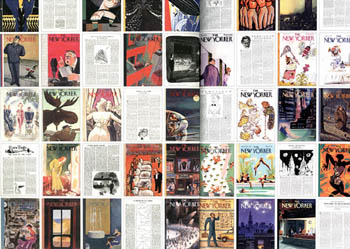![[Metroactive Books]](/books/gifs/books468.gif)
[ Books Index | Silicon Valley | Metroactive Home | Archives ]
Mag Fever
'The Complete New Yorker' on eight tiny DVDs fulfills a magazine hoarder's wildest dreams
By Michael S. Gant
WHEN I WAS young, a family friend passed along issues of The New Yorker so that I could read the cartoons. Thus began a lifelong absorption—verging on obsessive-compulsive—in the best magazine since Addison and Steele started The Tatler in 1709.
When I went off to college, I received a subscription of my own. The new issue always arrived before I had finished the last one, so I simply began saving copies. A single issue of the National Geographic (the other periodical of choice for literary hoarders) weighs more but comes only once a month. The New Yorker adds up four times as fast, like the buckets and brooms that bedeviled the sorcerer's apprentice.
Undeterred, I kept boxes full of the magazine in a storage unit—even enlisting the help of compliant friends to help me move the whole collection more than once. Eventually, said friends spirited away a stack, drilled a hole down the middle, attached a square of Lucite and made a New Yorker end table for me—I didn't get the point.
I finally stopped clinging to every issue about the time that celebrity-mongering Tina Brown became the editor, but I kept reading. Which brings us to the watershed publishing event of the year: The Complete New Yorker (Random House; $100).
This package of eight DVDs contains an exact reproduction of every page of every issue, from Feb. 21, 1925, to Feb. 14, 2005 (with updates available yearly). That's about 4,100 issues, with all the covers, all the ads, all the cartoons and all the articles visible at the click of a mouse. It is, in essence, a color microfilm collection of the magazine's history, minus the bulky reels, scratches and hooded projection apparatus used by libraries.
The articles are extensively indexed, thanks to the magazine's internal operations over the years—a real godsend, since The New Yorker disdained a table of contents for most of its existence. You can browse through the years, dipping into the zeitgeist of the flapper era, the Depression, World War II, the Vietnam War, etc., as your fancy takes you. Or you can search for favorite authors and trace their critical growth—Pauline Kael's movie reviews, beginning in January 1968, a signal date in film criticism; John Updike's book notes; James Thurber's humor pieces and drawings.
Many of the best stories have been anthologized elsewhere, but this collection offers a unique opportunity to read even the most casual pieces. Take Joseph Mitchell, whose most famous nonfiction tales got turned into the movie Joe Gould's Secret, but who remains something of an unsung genius of 20th-century journalism. Starting with his first Reporter at Large article in 1933, a still-amusing account of a marriage mill in Elkton, Md., Mitchell broke from the magazine's overly breezy, brittle early prose and pioneered its modern style, full of hard-worn
details, flashes of insight and brilliantly rendered dialogue.
The Complete New Yorker serves as an invaluable record of 20th-century thought, culture and commerce (the ads alone constitute a social history of the last 80 years) as well as a model for how to get such material into the marketplace at a reasonable price while balancing the needs of both the private and the public sectors. Because the magazine started publishing after the current cutoff date for public-domain material (1923), The New Yorker's copyright lawyers must have worked overtime to preserve the publication's entire archives.
Google's digital library, on the other hand, has run afoul of publishers' and authors' fears for any material still under copyright protection. Already, Google has started to emphasize that its project is designed only to produce indexical portions of books and not whole works, with publishers allowed to opt out of the database.
In a reader's utopia, the contents of all magazines, newspapers and books (after a prudent profit window) would be available in photographic form online for free, as if every computer were a terminal in the world's biggest library. In the meantime, a project like The New Yorker's is the next best thing.
[ Silicon Valley | Metroactive Home | Archives ]
![]()

New Yorker, New Yorker: Every page of every issue—what more could you ask for?
Send a letter to the editor about this story to letters@metronews.com.
From the December 7-13, 2005 issue of Metro, Silicon Valley's Weekly Newspaper.